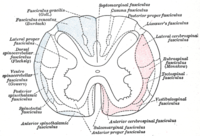
Photo from wikipedia
The genesis of central post-stroke pain (CPSP) is important but difficult to understand. We evaluated the involvement of the thalamic anterior part of the ventral posterolateral nucleus (VPLa) and central… Click to show full abstract
The genesis of central post-stroke pain (CPSP) is important but difficult to understand. We evaluated the involvement of the thalamic anterior part of the ventral posterolateral nucleus (VPLa) and central lateral nucleus (CL) in the occurrence of CPSP. Stereotactic thalamotomy was performed on the posterior part of the ventral lateral nucleus (VLp)-VPLa and CL in 9 patients with CPSP caused by deep-seated intracerebral hemorrhage. Computed tomography (CT) did not reveal definite thalamic lesion in 5 patients but did in 4 patients. Electrophysiological studies of these thalamic nuclei were carried out during the surgery. Anatomical studies using CT were performed in another 20 patients with thalamic hemorrhage who had clear consciousness but had sensory disturbance at onset. Neural activities were preserved and hyperactive and unstable discharges (HUDs) were often recognized along the trajectory in the thalamic VLp-VPLa in 5 patients without thalamic lesion. Surgical modification of this area ameliorated pain, particularly movement-related pain. Neural activities were hypoactive in the other 4 patients with thalamic lesion. However, neural activities were preserved and HUDs were sometimes recognized in the CL. Sensory responses were seen, but at low rate, in the sensory thalamus. Anatomical study showed that the thalamic lesion was obviously smaller in the patients with developing pain in the chronic stage. Change in neural activities around the cerebrovascular disease lesion in the thalamic VPLa or CL might affect the perception of sensory impulses or sensory processing in those thalamic nuclei, resulting in the genesis of CPSP.
Journal Title: Acta Neurochirurgica
Year Published: 2021
Link to full text (if available)
Share on Social Media: Sign Up to like & get
recommendations!